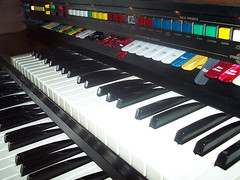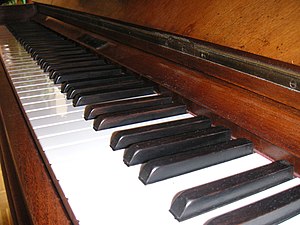Learn to Play Somewhere in My Memory on Piano
* Keyboard make-up
The keyboard uses the first 7 letters of the alphabet: A B C D E F G
A piano/keyboard is made up of black and white notes. The white notes are the regular letters. The black notes can mean 2 different things. As you move up the keyboard, from left to right, the black notes are indicated by #, which means sharp. So, the first black note after F going up the keyboard is F#, and the next black note is G#, etc. As you move down the keyboard, from right to left, the black notes are indicated by b, which means flat. So, the last black note before B going down the keyboard is Bb, and the next black note is Ab, etc. Make sure you know your notes.
* Hands and its members
When you sit down to play the keyboard, of course you are using 2 hands, Left Hand and Right Hand. On each hand there are 5 fingers. Each finger has a number (same for both hands):
Thumb = 1 Index = 2 Middle = 3 Ring = 4 Pinky = 5
* Movement on the keyboard
The first movement is a half step (HS). A half step is from one key to the very next key, regardless of color or direction. Here are some examples: F to F#, F# to F, B to C, C to B, D to Eb, Eb to D, etc.
The second movement is a whole step (WS). A whole step is from one key to the very next key w/one in between, regardless of color of direction. Here are some examples: F to G, G to F, B to C#, C# to B, Db to Eb, Eb to Db, etc.
All other movement on the keyboard is a combination of half and whole steps.
* Flats (b) and Sharps (#)
Whenever you flat (b) a note, it means to lower that note 1/2 step. No matter how many flats (b) you see, for each one you lower the note 1/2 step. Here are some examples:
Bb = B lowered 1/2 step
Bbb = B lowered two 1/2 steps
Bbbb = B lowered three 1/2 steps
Whenever you sharp (#) a note, it means to raise that note 1/2 step. No matter how many sharps (#) you see, for each one you raise the note 1/2 step. Here are some examples:
B# = B raised 1/2 step
B## = B raisedtwo 1/2 steps
B### = B raised three 1/2 steps
* Major scales
A scale is simply a group of notes that start and end on the same note. There are many, many types of scales involved in music, but the most basic scale is the major scale. The pattern for forming a major scale is:
First, pick a note. Then: _WS _ WS _ HS _ WS _ WS _ WS _ HS _
* Scale Degrees
After you have formed your major scale, each note in the major scale gets a number called a scale degree. The first note is 1, the second note is 2, etc. Here is an example in the key of C:
C = 1
D = 2
E = 3
F = 4
G = 5
A = 6
B = 7
Now, those are the scale degrees for the first octave. You can also keep going past an octave and scale degrees increase as well. Example:
C = 8
D = 9
E = 10
F = 11
G = 12
A = 13
As far as I know, this is as high as the scale degrees go in modern day practice. The purpose for these scale degrees is to help you with forming different types of chords and naming progressions.
* Chord Forming
Chords are built using the intervals of 3rds, i.e. every member of a chord is a 3rd apart. Here is an illustration of how it's done:
1. Lay out all the notes that are used on the keyboard or in a major scale:
A B C D E F G A B C D E F G A B C D E
2. Pick a note that you want to form a chord on and write it down. This note will be your root note: C
3. Once you got a root note, write down every other note after it:
C E G B D F A
The first 3 notes played together is your basic triad chord. (C-E-G)
The first 4 notes played together is your basic 7th chord. (C-E-G-B)
The first 5 notes played together is your basic 9th chord. (C-E-G-B-D)
The first 6 notes played together is your basic 11th chord. (C-E-G-B-D)
All 7 notes played together is your basic 13th chord. (C-E-G-B-D-F)
That's all there is to forming a chord. So, if you want to build a triad off A, you just say A-C-E. If you want to build a triad off B, you just say B-D-F.
* 4 basic types of chords
There are 4 basic types of chords that are the basis for all the chords used in music. They are major, minor, augmented, diminished. To add to the diminished chord, there is also the fully diminished chord. So really I guess you can say there are 5 basic types of chords. Forming each of these types of chords goes back to the principle of scale degrees. We use scale degrees so that forming these chords can be universal for any chord in any key.
major: 1 3 5
minor: 1 b3 5
diminished: 1 b3 b5
*fully diminished: 1 b3 b5 bb7 *just an extension of the regular diminished chord
augmented: 1 3 #5
For help on learning, practicing, and playing these basic chords, here are some links for you:
Basic Chord Fingerings:
http://forums.learngospelmusic.com/index.php/topic,16403.0.html
Basic Chords Practice:
http://forums.learngospelmusic.com/index.php/topic,22023.0.html
Other chords:
major 7th: 1 3 5 7
dominant 7th (V7): 1 3 5 b7
minor 7th: 1 b3 5 b7
6th: 1 3 5 6
add9th: 1 2 3 5
9th: 1 3 5 b7 9
11th: 1 3 5 b7 9 11
13th: 1 3 5 b7 9 11 13
*Each of these chords can also be altered by sharping (#) or flatting (b) a note(s) to form even more chords
* Chords built off scale degrees (major mode)
This special group of chords will be your main arsenal of chords to use in your music. If you are struggling with what chord to play with a bass note, you start with these chords:
1 (I) = Major
2 (ii) = minor
3 (iii) = minor
4 (IV) = Major
5 (V) = Major
6 (vi) = minor
7 (vii) = diminished
Examples in the key of C:
1 (I) = C-E-G
2 (ii) = D-F-A
3 (iii) = E-G-B
4 (IV) = F-A-C
5 (V) = G-B-D
6 (vi) = A-C-E
7 (vii) = B-D-F
* Inversions
Look at those basic chords, what if we were to play those same chords, but switch up the order of the notes. This is where inversions come from. An inversion is just switching the order of the members of a chord. How do you invert a chord? You invert a chord by taking the first letter and moving it to the end. Depending on how many notes there are in the chord, there can be many inversions. Here they are:
3-note chords: 4-note chords: 5-note chords:
root position = x y z root position = w x y z root position = v w x y z
1st inversion = y z x 1st inversion = x y z w 1st inversion = w x y z v
2nd inversion = z x y 2nd inversion = y z w x 2nd inversion = x y z v w
3rd inversion = z w x y 3rd inversion = y z v w x
4th inversion = z v w x y
* Intervals
The term interval refers to the distance between 2 notes. Here is a little breakdown of intervals used in music:
Intervals of 1, 4, and 5
These three intervals are the only intervals that get the name perfect intervals. Here are examples of these:
C-C = perfect unison
C-F = perfect 4th
C-G = perfect 5th
Now, let's say for instance you decide to raise the last note by 1/2 step:
C-F#
Do you still have a perfect 4th? No, now you have what is called an augmented 4th. Anytime you raise the last note of a perfect interval it becomes an augmented unison, 4th, or 5th:
C-C# = augmented unison
C-F# = augmented 4th (tritone)
C-G = augmented 5th
Now, let's say for instance you decided to lower the last note by 1/2 step:
C-Fb
Do you still have a perfect 4th? No, now you have what is called a diminished 4th. Anytime you lower the last note of a perfect interval it becomes a diminished unison, 4th, or 5th:
C-Cb = diminished unison
C-Fb = diminished 4th
C-Gb = diminished 5th (tritone)
Intervals of 2, 3, 6, 7
These intervals are different from the other 3 because they can be major, minor, augmented, or diminished intervals. First, I'll show the major intervals:
C-D = major 2nd
C-E = major 3rd
C-A = major 6th
C-B = major 7th
Now, to make these intervals minor, just lower the last note of the major interval 1/2 step:
C-Db = minor 2nd
C-Eb = minor 3rd
C-Ab = minor 6th
C-Bb = minor 7th
Now, to make these intervals augmented, just raise the last note or the major interval 1/2 step:
C-D# = augmented 2nd
C-E# = augmented 3rd
C-A# = augmented 6th
C-B# = augmented 7th
Now, to make these intervals diminished, just lower the last note or the major interval 1 whole step:
C-Dbb = diminished 2nd
C-Ebb = diminished 3rd
C-Abb = diminished 6th
C-Bbb = diminished 7th
After you have reached the diminished and augmented intervals, if the notes are raised or lowered again, it then becomes doubly augmented or diminished, triple augmented or diminished intervals, etc.
* Progressions
For help with progressions, here are some links for you:
Basic Progressions:
http://forums.learngospelmusic.com/index.php/topic,15720.0.html
More Advanced Progressions:
http://forums.learngospelmusic.com/index.php/topic,15731.0.html
Progressions Practice Routine:
http://forums.learngospelmusic.com/index.php/topic,18903.0.html
Progressions Practice Routine #2:
http://forums.learngospelmusic.com/index.php/topic,31384.0.html
http://www.learngospelmusic.com/forums/index.php/topic,36503.new.html#new
Explaining Progressions:
http://forums.learngospelmusic.com/index.php/topic,18550.0.html
Explaining Progressions part 2:
http://forums.learngospelmusic.com/index.php/topic,31163.0.html
Explaining Progressions part 3:
http://www.learngosppelmusic.com/forums/index.php/topic,33036.0.html
http://www.LadyDpiano.com
![Reblog this post [with Zemanta]](http://img.zemanta.com/reblog_e.png?x-id=33ef278e-2f0e-47a1-89ef-a7344188ba4d)




![Reblog this post [with Zemanta]](http://img.zemanta.com/reblog_e.png?x-id=ee565d13-1a68-49d0-aa4f-cd31470db9d9)

![Reblog this post [with Zemanta]](http://img.zemanta.com/reblog_e.png?x-id=1eb6c75d-bf89-4a0e-8245-a94090e42468)

![Reblog this post [with Zemanta]](http://img.zemanta.com/reblog_e.png?x-id=28bb8e35-f346-41c7-9fd5-980248600a03)


![Reblog this post [with Zemanta]](http://img.zemanta.com/reblog_e.png?x-id=b5f6f824-15c5-47f6-a8d4-15a462583d88)

![Reblog this post [with Zemanta]](http://img.zemanta.com/reblog_e.png?x-id=eb41c418-afd5-4bf7-80dc-f60052a0e43c)

![Reblog this post [with Zemanta]](http://img.zemanta.com/reblog_e.png?x-id=82c62137-ed81-4525-8720-276ffd0c75eb)

![Reblog this post [with Zemanta]](http://img.zemanta.com/reblog_e.png?x-id=cab033fb-ca34-4050-84f8-3b5bf0d95a25)


